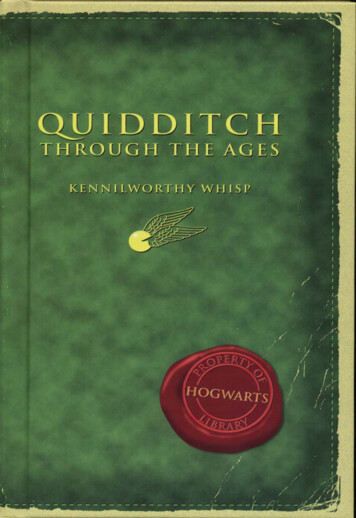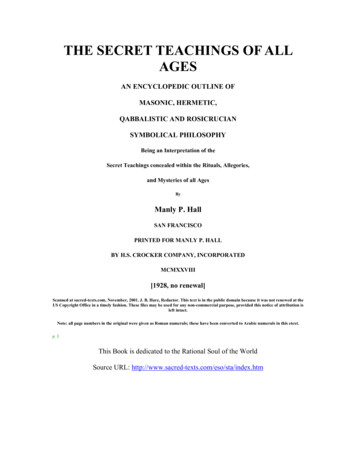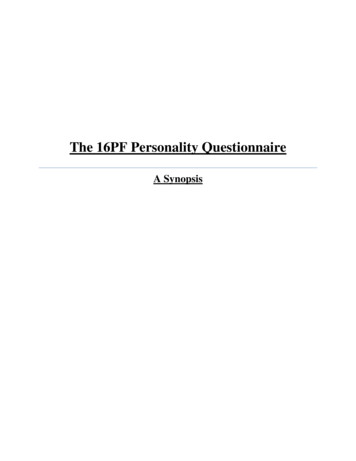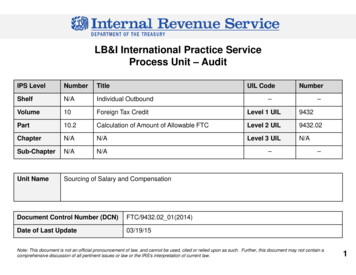
Transcription
Property of Hogwarts School LibraryName of borrowerDate due backA warning: If you rip, tear, shred, bend, fold, deface,disfigure, smear, smudge, throw, drop, or in anyother manner damage, mistreat, or show lack ofrespect towards this book, the consequences will beas awful as it is within my power to make them.Irma Pince, Hogwarts Librarian
About Comic Relief: A note from J. K. RowlingComic Relief is one of Britain’s most famous and successful charities.Begun in 1985, the organization has raised more than 250,000,000 forsuch charities as the Red Cross, Oxfam, Sight Savers, the InternationalHIV/AIDS Alliance, and Anti-Slavery International. The Harry Potter booksrepresent a new opportunity in Comic Relief’s quest to make a meaningfuldifference in people’s lives. A special Harry’s Books fund has been createdwhere twenty percent of the retail sales price less taxes from the sale ofQuidditch Through the Ages and Fantastic Beasts & Where to Find Themwill go to support children’s causes throughout the world. Every book soldcounts! Fifty cents will send a child to school for a week – and change hisor her life forever.Log on to www.comicrelief.com/harrysbooks and see how the moneyfrom the purchase of these books is being used to help others. The Harry’sBooks fund will support such efforts as the education of children, the fightagainst child slavery, and the reuniting of parents and children separatedby war. The fund will also educate people about the AIDS/HIV epidemicand will support child victims of landmine explosions.What is so wonderful about Comic Relief is that its costs aresponsored, therefore it does not take money for its own administration fromthe money given by the public. This means that in fact, because ofaccumulated interest, more than 100% of the money it raises it passes onto charity projects.I have always had a sneaking desire to write Fantastic Beasts &Where to Find Them and Quidditch Through the Ages, so when RichardCurtis of Comic Relief wrote to me, I thought it was a wonderful opportunityto help a charity I have always supported. Everyone involved with bringingthese books to fruition, the publishers, vendors, and retailers, has enabledthe contribution of a proportion of the cover price of these books to ComicRelief’s Harry’s Books fund.Thank you for buying this book!
QUIDDITCHTHROUGH THE AGESKennilworthy WhispArthur A. Levine BooksAN IMPRINT OF SCHOLASTIC PRESSin association with129B DIAGON ALLEY, LONDON
Praise for Quidditch Through the Ages“Kennilworthy Whisp’s painstaking research has uncovered a veritabletreasure trove of hitherto unknown facts about the sport of warlocks.A fascinating read.”— Bathilda Bagshot, author, A History of Magic“Whisp has produced a thoroughly enjoyable book; Quidditch fans aresure to find it both instructive and entertaining.”— Editor, Which Broomstick“The definitive work on the origins and history of Quidditch. Highlyrecommended.”— Brutus Scrimgeour, author, The Beaters’ Bible“Mr. Whisp shows a lot of promise. If he keeps up the good work, hemay well find himself sharing a photoshoot with me one of these days!”— Gilderoy Lockhart, author, Magical Me“Bet you anything it’ll be a best-seller. Go on, I bet you.”— Ludovic Bagman, England and Wimbourne Wasps Beater“I’ve read worse.”— Rita Skeeter, Daily ProphetText copyright 2001 by J. K. Rowling. Illustrations and hand lettering copyright 2001 by J. K. Rowling.All rights reserved. Published by Scholastic Press, a division of Scholastic Inc., Publishers since 1920. SCHOLASTIC,SCHOLASTIC PRESS, and the LANTERN LOGO are trademarks and/or registered trademarks of Scholastic Inc. HARRYPOTTER and all related characters, names, and related indicia are trademarks ofWarner Bros.No part of this publication may be reproduced, or stored in a retrieval system, or transmitted in any form or by any means,electronic, mechanical, photocopying, recording, or otherwise, without written permission of the publisher. For informationregarding permissions, write to Scholastic Inc., Attention: Permissions Department, 555 Broadway, New York, NY 10012.Scholastic Inc. has arranged for twenty percent of the retail sales price less taxes from the sale of this book to go to ComicRelief U. K.’s Harry’s Books fund. J. K. Rowling is donating all royalties to which she would be entitled. The purchase of thisbook is not tax deductible. Comic Relief may be contacted at: Comic Relief, 5th Floor, Albert Embankment, London SEI 77P,England (www.comicrelief.com). Comic Relief in the United Kingdom is not affiliated with the organization of the samename in the United Sutes.ISBN 0-439-32161-1Library of Congress Cataloging-in-Publication Data Available20 19 18 17 16 15 1407 08 09Printed in the United States and bound in Mexico23First hardcover boxset edition, September 2001
About the AuthorKWHISP is a renowned Quidditchexpert (and, he says, fanatic). He is the author of manyQuidditch-related works, including The Wonder of WigtownWanderers, He Flew Like a Madman (a biography of“Dangerous” Dai Llewellyn) and Beating the Bludgers – AStudy of Defensive Strategies in Quidditch.Kennilworthy Whisp divides his time between his homein Nottinghamshire and “wherever Wigtown Wanderers areplaying this week.” His hobbies include backgammon,vegetarian cookery, and collecting vintage broomsticks.ENNILWORTHY
ContentsForewordvii1. The Evolution of the Flying Broomstick12. Ancient Broom Games33. The Game From Queerditch Marsh74. The Arrival of the Golden Snitch105. Anti-Muggle Precautions156. Changes in Quidditch Since theFourteenth . Quidditch Teams of Britain and Ireland318. The Spread of Quidditch Worldwide389. The Development of the Racing Broom4710. Quidditch Today51vi
Forewordone of the mostQ popular titles in the HogwartsA schoolis library.Madam Pince,UIDDITCH THROUGH THEGESour librarian, tells me that it is “pawed about, dribbled on, andgenerally maltreated” nearly every day – a high compliment for anybook. Anyone who plays or watches Quidditch regularly will relishMr. Whisp’s book, as do those of us interested in wider wizardinghistory. As we have developed the game of Quidditch, so it hasdeveloped us; Quidditch unites witches and wizards from all walksof life, bringing us together to share moments of exhilaration,triumph, and (for those who support the Chudley Cannons)despair.It was with some difficulty, I must own, that I persuaded MadamPince to part with one of her books so that it might be copied forwider consumption. Indeed, when I told her it was to be madeavailable to Muggles, she was rendered temporarily speechless, andneither moved nor blinked for several minutes. When she came toherself she was thoughtful enough to ask whether I had taken leaveof my senses. I was pleased to reassure her on that point and wenton to explain why I had taken this unprecedented decision.Muggle readers will need no introduction to the work of ComicRelief U. K. (which, funnily enough, has nothing to do with theAmerican organization of the same name), so I now repeat myexplanation to Madam Pince for the benefit of witches and wizardswho have purchased this book. Comic Relief U. K. uses laughter tofight poverty, injustice, and disaster. Widespread amusement isconverted into large quantities of money (over 250 million dollarssince they started in 1985 – which is the equivalent of over 174million pounds or thirty-four million Galleons).Everyone involved in getting this book to you, from the author tothe publisher to the paper suppliers, printers, binders, andbooksellers, contributed their time, energy, and materials free or ata reduced cost, making it possible for twenty percent of the retailvii
sales price less taxes from the sale of this book to go to a fund setup in Harry Potter’s name by Comic Relief U. K. and J. K.Rowling. This fund was designed specifically to help children inneed throughout the world. By buying this book – and I wouldadvise you to buy it, because if you read it too long without handingover money you will find yourself the object of a Thief’s Curse –you too will be contributing to this magical mission.I would be deceiving my readers if I said that this explanationmade Madam Pince happy about handing over a library book toMuggles. She suggested several alternatives, such as telling thepeople from Comic Relief U. K. that the library had burned down,or simply pretending that I had dropped dead without leavinginstructions. When I told her that on the whole I preferred myoriginal plan, she reluctantly agreed to hand over the book, thoughat the point when it came to let go of it, her nerve failed her and Iwas forced to prise her fingers individually from the spine.Though I have removed the usual library book spells from thisvolume, I cannot promise that every trace has gone. Madam Pincehas been known to add unusual jinxes to the books in her care. Imyself doodled absentmindedly on a copy of Theories ofTransubstantial Transfiguration last year and next moment found thebook beating me fiercely about the head. Please be careful how youtreat this book. Do not rip out the pages. Do not drop it in thebath. I cannot promise that Madam Pince will not swoop down onyou, wherever you are, and demand a heavy fine.All that remains is for me to thank you for supporting ComicRelief U. K. and to beg Muggles not to try playing Quidditch athome; it is, of course, an entirely fictional sport and nobody reallyplays it. May I also take this opportunity to wish PuddlemereUnited the best of luck next season.viii
Chapter OneNThe Evolution of the FlyingBroomsticko spell yet devised enables wizards to fly unaided inhuman form. Those few Animagi who transforminto winged creatures may enjoy flight, but they are ararity. The witch or wizard who finds him- or herselftransfigured into a bat may take to the air, but, having abat’s brain, they are sure to forget where they want to gothe moment they take flight. Levitation is commonplace,but our ancestors were not content with hovering five feetfrom the ground. They wanted more. They wanted to flylike birds, but without the inconvenience of growingfeathers.We are so accustomed these days to the fact that everywizarding household in Britain owns at least one flyingbroomstick that we rarely stop to ask ourselves why.Why should the humble broom have become the one objectlegally allowed as a means of wizarding transport? Whydid we in the West not adopt the carpet so beloved of ourEastern brethren? Why didn’t we choose to produce flyingbarrels, flying armchairs, flying bathtubs – why brooms?Shrewd enough to see that their Muggle neighbourswould seek to exploit their powers if they knew their full1
extent, witches and wizards kept themselves tothemselves long before the International Statute ofWizarding Secrecy came into effect. If they were to keepa means of flight in their houses, it would necessarily besomething discreet, something easy to hide. Thebroomstick was ideal for this purpose; it required noexplanation, no excuse if found by Muggles, it was easilyportable and inexpensive. Nevertheless, the first broomsbewitched for flying purposes had their drawbacks.Records show that witches and wizards in Europe wereusing flying broomsticks as early as A.D. 962. A Germanilluminated manuscript of this period shows threewarlocks dismounting from their brooms with looks ofexquisite discomfort on their faces. Guthrie Lochrin, aScottish wizard writing in 1107, spoke of the “splinterfilled buttocks and bulging piles” he suffered after a shortbroom ride from Montrose to Arbroath.A medieval broomstick on display in the Museum ofQuidditch in London gives us an insight into Lochrin’sdiscomfort (see Fig. A). A thick knotty handle ofunvarnished ash, with hazel twigs bound crudely to oneend, it is neither comfortable nor aerodynamic. Thecharms placed upon it are similarly basic: It will onlymove forwards at one speed; it will go up, down, and stop.As wizarding families in those days made their ownbrooms, there was enormous variation in the speed,2
comfort, and handling of the transport available to them.By the twelfth century, however, wizards had learned tobarter services, so that a skilled maker of brooms couldexchange them for the potions his neighbour might makebetter than himself. Once broomsticks became morecomfortable, they were flown for pleasure rather thanmerely used as a means of getting from point A to point B.Chapter TwoAncient Broom GamesBroom sports emerged almost as soon as broomstickswere sufficiently advanced to allow fliers to turncorners and vary their speed and height. Early wizardingwritings and paintings give us some idea of the games ourancestors played. Some of these no longer exist; othershave survived or evolved into the sports we know today.The celebrated annual broom race of Sweden datesfrom the tenth century. Fliers race from Kopparberg to3
Arjeplog, a distance of slightly over three hundred miles.The course runs straight through a dragon reservation,and the vast silver trophy is shaped like a Swedish ShortSnout. Nowadays this is an international event andwizards of all nationalities congregate at Kopparberg tocheer the starters, then Apparate to Arjeplog tocongratulate the survivors.The famous painting Günther der Gewalttätige ist der Gewinner(“Gunther the Violent Is the Winner”), dated 1105, showsthe ancient German game of Stichstock. A twenty-foothigh pole was topped with an inflated dragon bladder.One player on a broomstick had the job of protecting thisbladder. The bladder-guardian was tied to the pole by arope around his or her waist, so that he or she could notfly further than ten feet away from it. The rest of theplayers would take it in turns to fly at the bladder andattempt to puncture it with the specially sharpened endsof their brooms. The bladder-guardian was allowed to usehis or her wand to repel these attacks. The game endedwhen the bladder was successfully punctured, or thebladder-guardian had either succeeded in hexing allopponents out of the running or collapsed fromexhaustion. Stichstock died out in the fourteenth century.In Ireland the game of Aingingein flourished, thesubject of many an Irish ballad (the legendary wizardFingal the Fearless is alleged to have been an Aingingein4
champion). One by one the players would take the Dom,or ball (actually the gallbladder of a goat), and speedthrough a series of burning barrels set high in the air onstilts. The Dom was to be thrown through the final barrel.The player who succeeded in getting the Dom through thelast barrel in the fastest time, without having caught fireon the way, was the winner.Scotland was the birthplace of what is probably themost dangerous of all broom games – Creaothceann.The game features in a tragic Gaelic poem of the eleventhcentury, the first verse of which says, in translation:The players assembled, twelve fine, hearty men,They strapped on their cauldrons, stood poised to fly,At the sound of the horn they were swiftly airborneBut ten of their number were fated to die.Creaothceann players each wore a cauldron strapped tothe head. At the sound of the horn or drum, up to ahundred charmed rocks and boulders that had beenhovering a hundred feet above the ground began to falltowards the earth. The Creaothceann players zoomedaround trying to catch as many rocks as possible in theircauldrons. Considered by many Scottish wizards to bethe supreme test of manliness and courage, Creaothceannenjoyed considerable popularity in the Middle Ages,5
despite the huge number of fatalities that resulted from it.The game was made illegal in 1762, and though Magnus“Dent-Head” Macdonald spearheaded a campaign for itsreintroduction in the 1960s, the Ministry of Magicrefused to lift the ban.Shuntbumps was popular in Devon, England. Thiswas a crude form of jousting, the sole aim being to knockas many other players as possible off their brooms, the lastperson remaining on their broom winning.Swivenhodge began in Herefordshire. LikeStichstock, this involved an inflated bladder, usually apig’s. Players sat backwards on their brooms and battedthe bladder backwards and forwards across a hedge withthe brush ends of their brooms. The first person to missgave their opponent a point. First to reach fifty points wasthe winner.Swivenhodge is still played in England, though it hasnever achieved much widespread popularity; Shuntbumpssurvives only as a children’s game. At Queerditch Marsh,however, a game had been created that would one daybecome the most popular in the wizarding world.6
Chapter ThreeThe Game From Queerditch MarshWe owe our knowledge of the rude beginnings ofQuidditch to the writings of the witch GertieKeddle, who lived on the edge of Queerditch Marsh in theeleventh century. Fortunately for us, she kept a diary, nowin the Museum of Quidditch in London. The excerptsbelow have been translated from the badly spelled Saxonof the original.Tuesday. Hot. That lot from across the marsh have been at itagain. Playing a stupid game on their broomsticks. A bigleather ball landed in my cabbages. I hexed the man whocame for it. I’d like to see him fly with his knees on back tofront, the great hairy hog.Tuesday. Wet. Was out on the marsh picking nettles.Broomstick idiots playing again. Watched for a bit frombehind a rock. They’ve got a new ball. Throwing it to eachother and trying to stick it in trees at either end of themarsh. Pointless rubbish.Tuesday. Windy. Gwenog came for nettle tea, then invitedme out for a treat. Ended up watching those numbskulls7
playing their game on the marsh. That big Scottish warlockfrom up the hill was there. Now they’ve got two big, heavyrocks flying around trying to knock them all off theirbrooms. Unfortunately didn’t happen while I was watching.Gwenog told me she often played herself. Went home indisgust.These extracts reveal much more than Gertie Keddlecould have guessed, quite apart from the fact that she onlyknew the name of one of the days of the week. Firstly, theball that landed in her cabbage patch was made of leather,as is the modern Quaffle – naturally, the inflated bladderused in other broom games of the period would bedifficult to throw accurately, particularly in windyconditions. Secondly, Gertie tells us that the men were“trying to stick it in trees at either end of the marsh” –apparently an early form of goal-scoring. Thirdly, she givesus a glimpse of the forerunners of Bludgers. It isimmensely interesting that there was a “big Scottishwarlock” present. Could he have been a Creaothceannplayer? Was it his idea to bewitch heavy rocks to zoomdangerously around the pitch, inspired by the bouldersused in his native game?We find no further mention of the sport played onQueerditch Marsh until a century later, when the wizardGoodwin Kneen took up his quill to write to his8
Norwegian cousin Olaf. Kneen lived in Yorkshire, whichdemonstrates the spread of the sport throughout Britainin the hundred years after Gertie Keddle first witnessedit. Kneen’s letter is deposited in the archives of theNorwegian Ministry of Magic.Dear Olaf,How are you? I am well, though Gunhilda had got atouch of dragon pox.We enjoyed a spirited game of Kwidditch last Saturdaynight, though poor Gunhilda was not up to playing Catcher,and we had to use Radulf the blacksmith instead. The teamfrom Ilkley played well though was no match for us, for wehad been practising hard all month and scored forty-twotimes. Radulf got a Blooder in the head because old Uggawasn’t quick enough with his club. The new scoring barrelsworked well. Three at each end on stilts, Oona from the inngave us them. She let us have free mead all night because wewon as well. Gunhilda was a bit angry I got back so late. Ihad to duck a couple of nasty jinxes but I’ve got my fingersback now.I’m sending this with the best owl I’ve got, hope he makes it.Your cousin,GoodwinHere we see how far the game has progressed in a century.Goodwin’s wife was to have played “Catcher” – probablythe old term for Chaser. The “Blooder” (undoubtedly9
Bludger) that hit Radulf the blacksmith should have beenfended off by Ugga, who was obviously playing Beater, ashe was carrying a club. The goals are no longer trees, butbarrels on stilts. One crucial element in the game was stillmissing, however: the Golden Snitch. The addition of thefourth Quidditch ball did not occur until the middle of thethirteenth century and it came about in a curious manner.Chapter FourFThe Arrival of the Golden Snitchrom the early 1100s, Snidget-hunting had beenpopular among many witches and wizards. TheGolden Snidget (see Fig. B) is today a protected species,but at that time Golden Snidgets were common in northernEurope, though difficult to detect by Muggles because oftheir aptitude at hiding and their very great speed.The diminutive size of the Snidget, coupled with itsremarkable agility in the air and talent at avoidingpredators, merely added to the prestige of wizards whocaught them. A twelfth-century tapestry preserved in theMuseum of Quidditch shows a group setting out to catcha Snidget. In the first portion of the tapestry, somehunters carry nets, others use wands, and still othersattempt to catch the Snidget with their bare hands. The10
tapestry reveals the fact that the Snidget was oftencrushed by its captor. In the final portion of the tapestrywe see the wizard who caught the Snidget being presentedwith a bag of gold.Snidget-hunting was reprehensible in many ways. Everyright-minded wizard must deplore the destruction ofthese peace-loving little birds in the name of sport.Moreover, Snidget-hunting, which was usually under-taken in broad daylight, led to more Muggle broomsticksightings than any other pursuit. The Wizards’ Council ofthe time, however, was unable to curb the sport’spopularity – indeed, it appears that the Council itself sawlittle wrong with it, as we shall see.Snidget-hunting finally crossed paths with Quidditch in1269 at a game attended by the Chief of the Wizards’11
Council himself, Barberus Bragge. We know this becauseof the eyewitness account sent by Madam ModestyRabnott of Kent to her sister Prudence in Aberdeen (thisletter is also on display in the Museum of Quidditch).According to Madam Rabnott, Bragge brought a cagedSnidget to the match and told the assembled players thathe would award one hundred and fifty Galleons1 to theplayer who caught it during the course of the game.Madam Rabnott explains what happened next:The players rose as one into the air, ignoring theQuaffle and dodging the Blooders. Both Keepersabandoned the goal baskets and joined the hunt. Thepoor little Snidget shot up and down the pitch seekinga means of escape, but the wizards in the crowd forcedit back with Repelling Spells. Well, Pru, you knowhow I am about Snidget-hunting and what I get likewhen my temper goes. I ran onto the pitch andscreamed, “Chief Bragge, this is not sport! Let theSnidget go free and let us watch the noble game ofCuaditch which we have all come to see!” If you’llbelieve me. Pru, all the brute did was laugh andthrouw the empty birdcage at me. Well, I saw red,Pru, I really did. When the poor little Snidget flew1. Equivalent to over a million Galleons today. Whether Chief Braggeintended to pay or not is a moot point.12
My way I did a Summoning Charm. You know howgood my Summoning Charms are, Pru – of course itwas easier for me to aim properly, not being mountedon a broomstick at the time. The little bird camezooming into my hand. I stuffed it down the front ofmy robes and ran like fury.Well, they caught me, but not before I’d got out ofthe crowds and released the Snidget. Chief Braggewas very angry and for a moment I thought I’d endup a horned toad, or worse, but luckily his advisorscalmed him down and I was only fined ten Galleonsfor disrupting the game. Of course I’ve never had tenGalleons in my life, so that’s the old home gone.I’ll be coming to live with you shortly, luckily theydidn’t take the Hippogriff. And I’ll tell you this,Pru, Chief Bragge would have lost my vote if I’dhad one.Your loving sister,ModestyMadam Rabnott’s brave action might have saved oneSnidget, but she could not save them all. Chief Bragge’sidea had forever changed the nature of Quidditch.Golden Snidgets were soon being released during allQuidditch games, one player on each team (the Hunter)having the sole task of catching it. When the bird was13
killed, the game was over and the Hunter’s team wasawarded an extra one hundred and fifty points, inmemory of the one hundred and fifty Galleons promisedby Chief Bragge. The crowd undertook to keep theSnidget on the pitch by using the Repelling Spellsmentioned by Madam Rabnott.By the middle of the following century, however,Golden Snidget numbers had fallen so low that theWizards’ Council, now headed by the considerably moreenlightened Elfrida Clagg, made the Golden Snidget aprotected species, outlawing both its killing and its use inQuidditch games. The Modesty Rabnott SnidgetReservation was founded in Somerset and a substitute forthe bird was frantically sought to enable the game ofQuidditch to proceed.The invention of the Golden Snitch is credited to thewizard Bowman Wright of Godric’s Hollow. WhileQuidditch teams all over the country tried to find birdsubstitutes for the Snidget, Wright, who was a skilledmetal-charmer, set himself to the task of creating a ballthat mimicked the behaviour and flight patterns of theSnidget. That he succeeded perfectly is clear from themany rolls of parchment he left behind him on his death(now in the possession of a private collector), listing theorders that he had received from all over the country. TheGolden Snitch, as Bowman called his invention, was a14
walnut-sized ball exactly the weight of a Snidget. Itssilvery wings had rotational joints like the Snidget’s,enabling it to change direction with the lightning speedand precision of its living model. Unlike the Snidget,however, the Snitch had been bewitched to remain withinthe boundaries of the field. The introduction of theGolden Snitch may be said to have finished the processbegun three hundred years before on Queerditch Marsh.Quidditch had been truly born.Chapter FiveIAnti-Muggle Precautionsn 1398 the wizard Zacharias Mumps set down the firstfull description of the game of Quidditch. He began byemphasising the need for anti-Muggle security whileplaying the game: “Choose areas of deserted moorland farfrom Muggle habitations and make sure that you cannotbe seen once you take off on your brooms. MuggleRepelling Charms are useful if you are setting up apermanent pitch. It is advisable, too, to play at night.”We deduce that Mumps’s excellent advice was notalways followed from the fact that the Wizards’ Counciloutlawed all Quidditch-playing within fifty miles of towns15
in 1362. Clearly the popularity of the game was increasingrapidly, for the Council found it necessary to amend theban in 1368, making it illegal to play within a hundredmiles of a town. In 1419, the Council issued the famouslyworded decree that Quidditch should not be played“anywhere near any place where there is the slightestchance that a Muggle might be watching or we’ll see howwell you can play whilst chained to a dungeon wall.”As every school-age wizard knows, the fact that we flyon broomsticks is probably our worst-kept secret. NoMuggle illustration of a witch is complete without abroom and however ludicrous these drawings are (fornone of the broomsticks depicted by Muggles could stayup in the air for a moment), they remind us that we werecareless for too many centuries to be surprised thatbroomsticks and magic are inextricably linked in theMuggle mind.Adequate security measures were not enforced until theInternational Statute of Wizarding Secrecy of 1692 madeevery Ministry of Magic directly responsible for theconsequences of magical sports played within theirterritories. This subsequently led, in Britain, to theformation of the Department of Magical Games andSports. Quidditch teams that flouted the Ministryguidelines were henceforth forced to disband. The mostfamous instance of this was the Banchory Bangers, a16
Scottish team renowned not only for their poor Quidditchskills but also for their post-match parties. After their1814 match against the Appleby Arrows (see ChapterSeven), the Bangers not only allowed their Bludgers tozoom away into the night, but also set out to capture aHebridean Black for their team mascot. Ministry of Magicrepresentatives apprehended them as they were flyingover Inverness and the Banchory Bangers never playedagain.Nowadays Quidditch teams do not play locally, buttravel to pitches, which have been set up by theDepartment of Magical Games and Sports whereadequate anti-Muggle security is maintained. As ZachariasMumps so rightly suggested six hundred years ago,Quidditch pitches are safest on deserted moors.Chapter SixChanges in Quidditch Since theFourteenth CenturyPitchZacharias Mumps describes the fourteenth-century pitchas oval-shaped, five hundred feet long, and a hundred andeighty feet wide with a small central circle (approximatelytwo feet in diameter) in the middle. Mumps tells us that17
the referee (or Quijudge, as he or she was then known),carried the four balls into this central circle while thefourteen players stood around him. The moment the ballswere released (the Quaffle was thrown by the referee; see“Quaffle” below), the players raced into the air. Thegoalposts in Mumps’s time were still large baskets onpoles, as seen in Fig. C.In 1620 Quintius Umfravillewrote a book called The NobleSport of Warlocks, which includeda diagram of the seventeenthcentury pitch (see Fig. D). Herewe see the addition of what weknow as “scoring areas” (see“Rules” below). The baskets ontop of the goalposts wereconsiderably smaller and higherthan in Mumps’s time.By 1883 baskets had ceased tobe used
1 Chapter One The Evolution of the Flying Broomstick N o spell yet devised enables wizards to fly unaided in human form. Those few Animagi who transform into winged creatures may enjoy flight, but they are a rarity. The witch or wizard who finds him- or herself t










